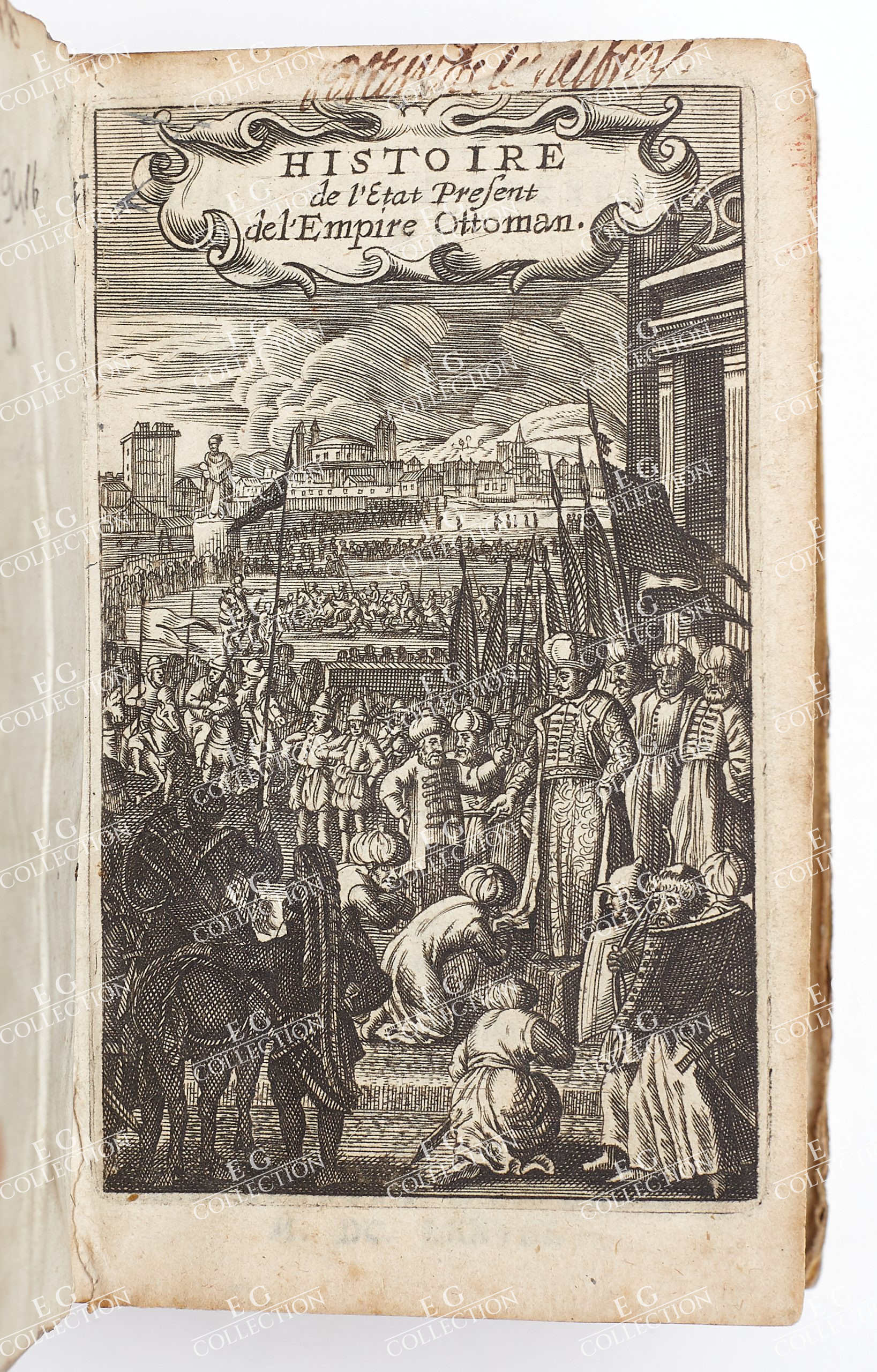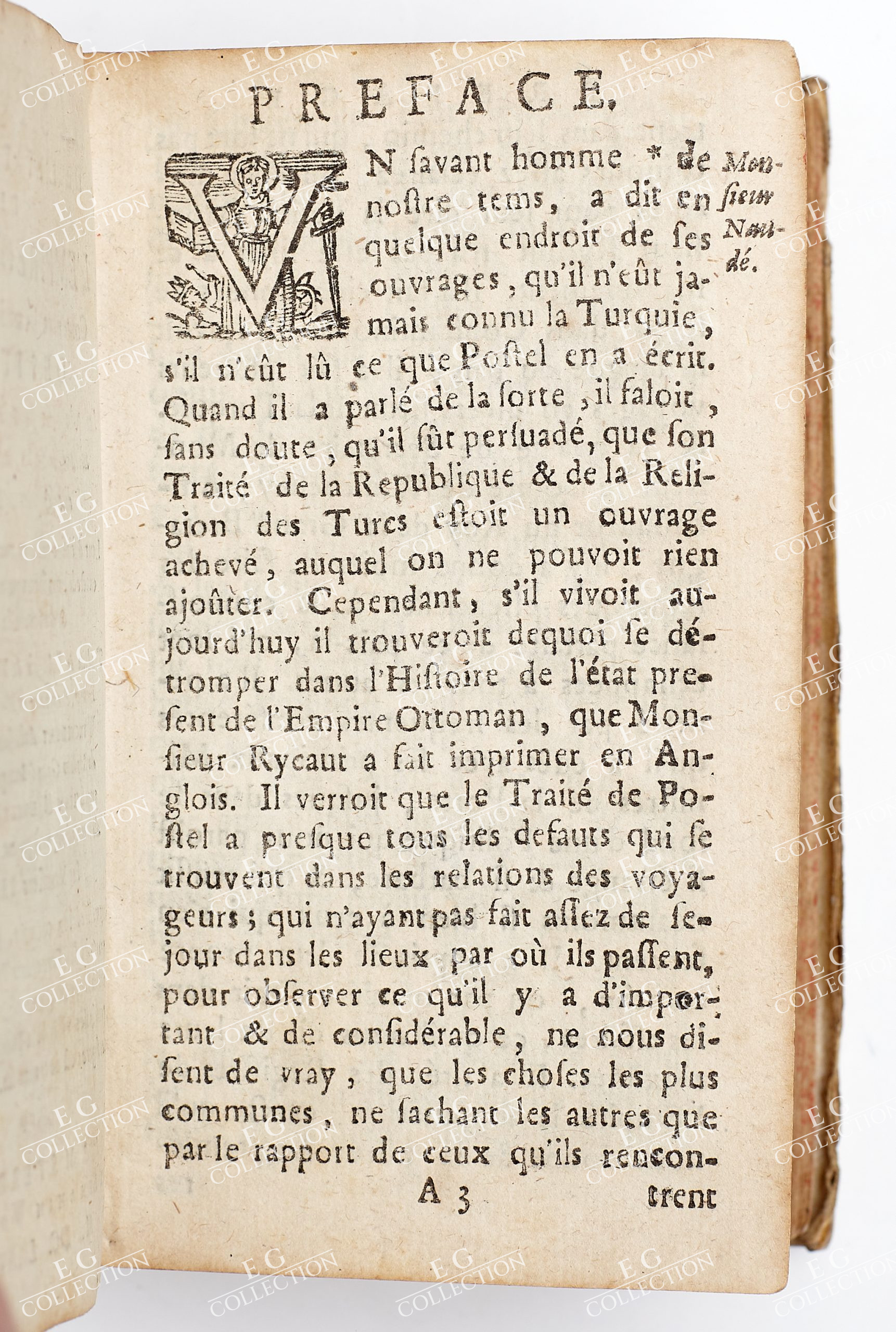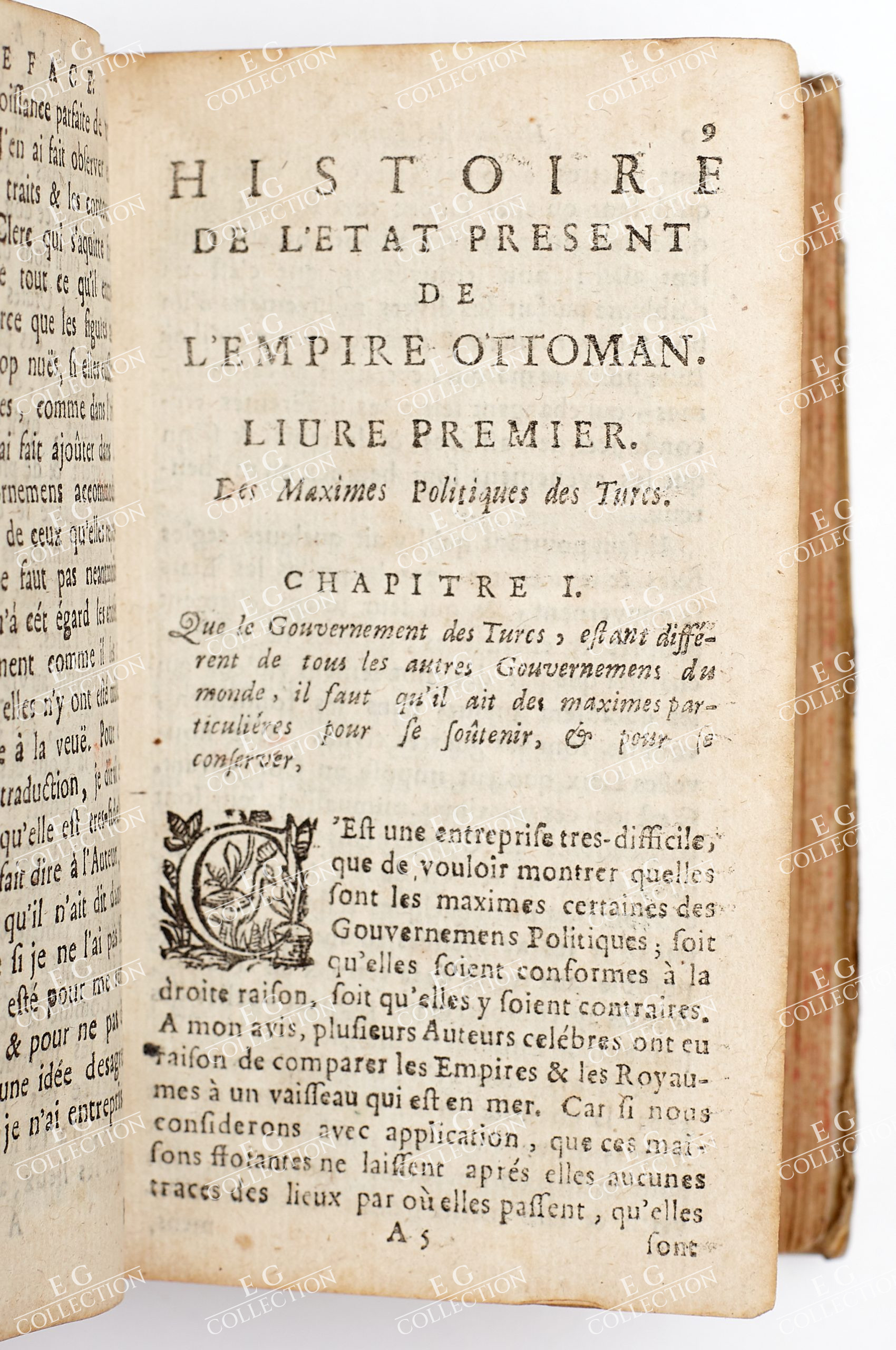RYCAUT
HISTOIRE DE L’ETAT PRESENT DE L’EMPIRE OTTOMAN
Contenant les maximes Politiques.
Traduit de l’Anglois de Monsieur Ricaut [.] par Monsieur Briot.
Paul RYCAUT
Amsterdam, 1678
Paul Rycaut (1628-1700), an English-born diplomat and writer, was the tenth son of a merchant who settled in London. He studied at the University of Cambridge, traveled for several years in Europe, Asia and Africa, and in 1661 came to the capital of the Ottoman Empire during the reign of Sultan Mehmet IV (Mehmet the Hunter) as an attaché in the embassy of King Charles II of England.
During his eight-year stay here, Rycaut studied the customs and religions of the Ottoman Turks from his position. In the meantime, in London, where he returned twice with various missions, he published the “Capitulations”, which contained the articles of the peace treaty signed by his country with the Porte. Rycaut’s diplomatic skills and his ability to obtain privileges, especially for British ships sailing in the sea waters under Ottoman rule, led to his appointment as the British Consul General in Izmir in a short time. He remained in this position for 11 years (1667-1678), during which time Rycaut managed to obtain favorable terms for his country in England’s commercial relations with the Middle East.
In 1685, after being away from his homeland for 24 years, he continued his diplomatic mission in Ireland and managed not to lose his political power despite all the internal political turmoil of his country. His death coincides with the year 1700.
One of the most important personalities among the British who operated in the Eastern Mediterranean, the book “The present State of the Ottoman Empire”, published in London in 1667, was reprinted one after the other and translated into other European languages. Rycaut’s second important work is “Greek and Armenian Churches”, which he wrote on the order of the king of England, published in London in 1679 and translated into French in 1690. His third important work is “The History of the Turkish Empire” published in London in 1680. Rycaut’s His books on the social institutions and history of the Ottoman state have been a handbook for many years to get to know this Eastern empire, which is magnificent in the eyes of a Westerner but has different kinds of beliefs, and has influenced all the texts that have been written later.
In his treatise on the Greek Orthodox Church, Rycaut was the first Westerner to sympathize with the Orthodox, although he agreed with the view that both the clergy and the people were in misery due to ignorance. In addition to expressing his astonishment at the survival of the Orthodox Church, he also speaks of the tyranny of the Roman Church. He writes about religious abstinence and festivals, pagan customs and traditions, religious ceremonies in which the icons of saints are circulated, criticizes the artistic style of the icons as quite rude, intervenes in the discussions and arrangements between the clergy and the patriarch, and devotes a chapter of his book to Athos (Aynaroz) itself. In Part II of the book, he describes his visit to the “seven churches of the apocalypse in Anatolia”. In chapter III he writes about the election of patriarchs and the hierarchy of the Church, and from chapter VII to chapter X and from chapter XII to chapter XV he writes about religious mysteries (sanctifying rites). Chapters V and VI deal with the religious abstinence and feasts of the Greek Orthodox, while Chapters XVI and XVII deal with liturgies and icon worship. Finally, chapters XVIII and XIX deal with the presence and dominance of Western Christians on the islands of the Aegean Sea, the question of “From whom did the Holy Spirit come (from the Father or from the Father and the Son)”, the holy scriptures, and the hidden (apocrypha) Gospels.
by Ioli Vingopoulou
İngiliz asıllı diplomat ve yazar Paul Rycaut (1628-1700) Londra’ya yerleşmiş bir tüccarın onuncu oğluydu. Cambridge üniversitesinde okur, birkaç yıl boyunca Avrupa Asya ve Afrika’da seyahat eder ve 1661 yılında, İngiltere kralı II. Charles sefaretinde ataşe yazman olarak sultan Mehmet IV. (Avcı Mehmet) döneminde Osmanlı İmparatorluğu başkentine gelir.
Burada kaldığı sekiz yıl zarfında, Rycaut, bulunduğu mevkiiden Osmanlı Türklerinin örf adet ve dinlerini inceler. Bu arada çeşitli görevlerle iki kez döndüğü Londra’da, ülkesinin Babıali ile imzaladığı barış antlaşması maddelerini içeren “Kapitülasyonlar”ı yayınlar. Rycaut’un diplomasi yetisi ve özellikle Osmanlı hakimiyetindeki deniz sularında gezen İngiliz gemileri için ayrıcalıklar elde etmeyi başarması, kendisinin kısa zamanda İngiltere’nin İzmir’deki Başkonsolos görevine atanmasına yol açar. Bu görevde 11 yıl kalır (1667-1678) ve bu süre içinde, Rycaut, İngiltere’nin Orta Doğu ile ticarî ilişkilerinde ülkesinin leyhine şartlar elde etmeyi başarır.
1685 yılında, 24 yıl boyunca memleketinden uzak kaldıktan sonra diplomatik görevini İrlanda’da sürdürür ve ülkesinin tüm iç siyasal çalkantılarına karşın siyasi gücünü yitirmemeyi başarır. Ölümü 1700 yılına rastlar.
Doğu Akdeniz’de faaliyet göstermiş İngilizler arasında en önemli kişiliklerden biri olan Rycaut’un kaleme aldığı eserlerden, Londra’da 1667 yılında yayınlanan “The present State of the Ottoman Empire” adlı kitap üstüste yeniden basılır ve öteki Avrupa dillerine çevrilir. Rycaut’un ikinci önemli eseri, İngiltere kralının siparişi üzerine yazdığı, 1679 yılında Londra’da yayınlanan ve 1690’da fransızcaya çevrilen “Greek and Armenian Churches”adlı kitaptır. Üçüncü önemli eseriyse 1680 yılında Londra’da basılan “The History of the Turkish Empire” adlı kitaptır. Rycaut’un Osmanlı devletinin toplumsal kurumları ve tarihine ilişkin kitapları, bir Batılının gözünde muhteşem olan ancak değişik tür inançlar güden bu Doğu imparatorluğunu tanıyabilmek için yıllarca el kitabı olmuş ve daha sonra yazılmış metinlerin tümünü etkilemiştir.
Rum Ortodoks Kilisesi ile ilgili kaleme aldığı incelemede, Rycaut, cehalet yüzünden hem ruhban sınıfının hem halkın sefalet içinde olduğu görüşüne katılmakla birlikte, ortodokslara sempati gösteren ilk Batılıdır. Ortodoks kilisesinin hayatta kalışına şaşkınlığını belirtmekten başka Roma Kilisesi’nin zorbalığından da söz eder. Dinî perhiz ve bayramlar, pagan örf ve adetler, aziz ikonalarının dolaştırıldığı dinî törenler hakkında yazar, ikonaların sanat uslubunu oldukça kaba bularak eleştirir, din adamlarının patrikle aralarındaki tartışma ve düzenlemelere müdahale eder ve kitabının bir bölümünü başlıbaşına Athos (Aynaroz)’a ayırır. Kitabın II. bölümünde “Anadolu’daki mahşerin yedi kilisesi”ne ziyaretini anlatır. III. bölümde patriklerin seçimi ve Kilise hiyerarşisi hakkında, VII. bölümden X. bölüme ve XII. bölümden XV. bölüme dek dinî sırlar (kutsallaştırıcı ayinler) hakkında açıklamalar yazar. V. ve VI. bölümler Rum Ortodoksların dinî perhiz ve yortularını (bayram), XVI. ve XVII. bölümler ise ayinler ve ikona tapınmasını inceler. Son olarak XVIII. ve XIX. bölümler Batılı hristiyanların Ege denizi adalarındaki varlığı ve hakimiyeti, “Kutsal Ruh kimden çıktı (Baba’dan mı yoksa Baba ve Oğul’dan mı)” sorusu, ayazmalar ve gizli (apokrif) İnciller hakkındadır.
Yazan: İoli Vingopoulou
$ 4.500,00
1 in stock









